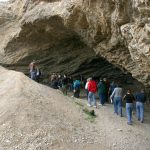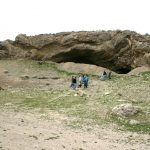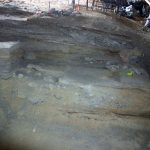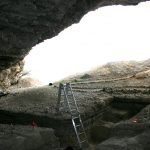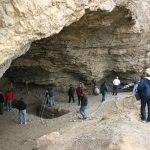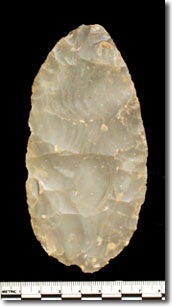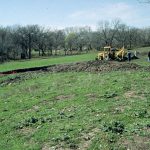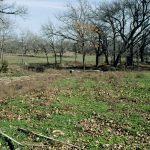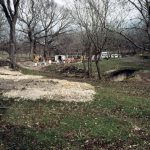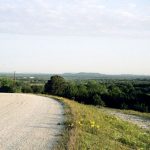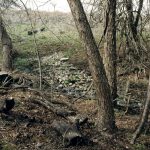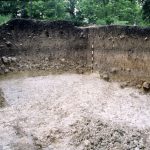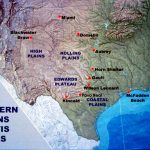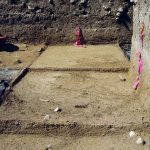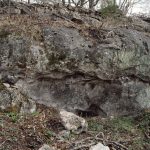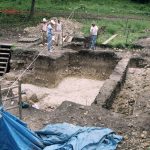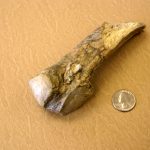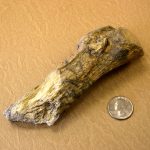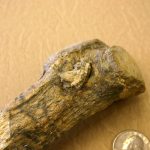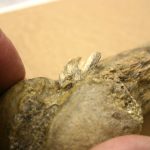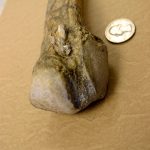Research
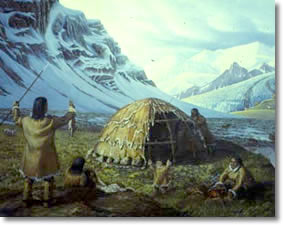 Research Conducted by the Center
Research Conducted by the Center
Research at the Center for the Study of the First Americans is interdisciplinary and focused on the development and synthesis of new knowledge on the peopling of the Americas. To address questions about the first Americans, Center faculty and students conduct field investigations at archaeological sites in northeast Asia, Alaska, Canada, the 48 contiguous United States, Mexico, Central America, and South America. We prospect for late Pleistocene sites using geoarchaeological methods. We determine the age of important sites using different dating techniques. We analyze ancient artifact, animal, and plant assemblages from early sites that can provide important insights into the technologies, subsistence strategies, and settlement patterns of the First Americans and their ancestors in the Old World. We collaborate with molecular biologists to recover ancient DNA from archaeological sites to address genetic relationships between the ancient peoples of the Old and New World. These studies develop the empirical foundation of evidence required to explain the peopling of the Americas.
The North Star Archaeological Research Program
 The North Star Archaeological Research Program helps to fund much of the archaeological research by Center faculty. Projects are funded from earnings generated by a permanent endowment created at Texas A&M University by Joe and Ruth Cramer in 2002. Their vision and generosity has substantially contributed to our knowledge of the First Americans. Additional funding for research is obtained from government granting agencies such as the NSF, private foundations, and other sources.
The North Star Archaeological Research Program helps to fund much of the archaeological research by Center faculty. Projects are funded from earnings generated by a permanent endowment created at Texas A&M University by Joe and Ruth Cramer in 2002. Their vision and generosity has substantially contributed to our knowledge of the First Americans. Additional funding for research is obtained from government granting agencies such as the NSF, private foundations, and other sources.
Center Projects
This is a brief description of multi-year Center research projects undertaken by Center faculty. For student research projects see the student profiles under Education.
Texas
Hall’s Cave
From 2017-2019, interdisciplinary fieldwork has been undertaken at Hall’s Cave in cooperation with Tom Stafford and Joshua Keene. Two seasons were spent excavating the cave sediments which are about 4 m thick and range from 25,000 cal yr B.P. to the historic time period. The cave contains both a paleontological and archaeological record. DNA extracted from the sediments and bones in the cave preserve an environmental record of vegetation and faunal change over time. Additional studies of the sediments are underway. In 2019, a surface survey was undertaken to record the temporal and spatial record of occupation outside the cave.
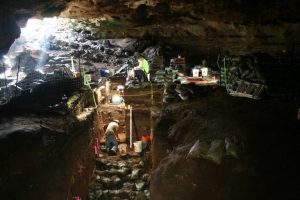
Debra L. Friedkin, Texas (Buttermilk Creek)
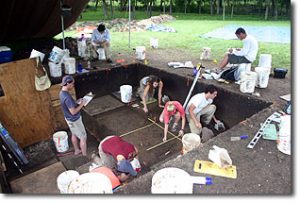 During the summer of 2006-2009, 2011, and 2015-2016, the Center excavated at the Debra L. Friedkin site in central Texas. This site is located along Buttermilk Creek, just 200 m downstream of the Gault site. Two large excavation blocks have been excavated. Excavation Block A is located on the western end of the site. Here there is a long sequence of occupation within floodplain sediments. Late Prehistoric and Archaic artifacts are found in the upper and middle portions of the floodplain sediments. Below this is a 10 cm thick Clovis horizon. The types of artifacts found indicate that this area was a Clovis camp. Additional artifacts, including bifaces and blades, were found below the Clovis horizon and may be older. Excavation Block B is located on the eastern end of the site. In this area, a Clovis activity area was encountered with many tools. Mike Waters directed this project.
During the summer of 2006-2009, 2011, and 2015-2016, the Center excavated at the Debra L. Friedkin site in central Texas. This site is located along Buttermilk Creek, just 200 m downstream of the Gault site. Two large excavation blocks have been excavated. Excavation Block A is located on the western end of the site. Here there is a long sequence of occupation within floodplain sediments. Late Prehistoric and Archaic artifacts are found in the upper and middle portions of the floodplain sediments. Below this is a 10 cm thick Clovis horizon. The types of artifacts found indicate that this area was a Clovis camp. Additional artifacts, including bifaces and blades, were found below the Clovis horizon and may be older. Excavation Block B is located on the eastern end of the site. In this area, a Clovis activity area was encountered with many tools. Mike Waters directed this project.
| Read More
Waters, Michael R., Joshua L. Keene, Steven L. Forman, Elton R. Prewitt, David L. Carlson, James E. Wiederhold (2018) Pre-Clovis projectile points at the Debra L. Friedkin site, Texas—Implications for the Late Pleistocene peopling of the Americas. Science Advances 24 October 2018. (pdf) Waters, Michael R., Steven L. Forman, Thomas A. Jennings, Lee C. Nordt, Steven G. Driese, Joshua M. Feinberg, Joshua L. Keene, Jessi Halligan, Anna Lindquist, James Pierson, Charles T. Hallmark, Michael B. Collins, James E. Wiederhold (2011) The Buttermilk Creek Complex and the Origins of Clovis at the Debra L. Friedkin Site, Texas. Science 331:1599-1603. (pdf ), (pdf online supporting materials) |
Beringia
The Alaska Range Uplands Project
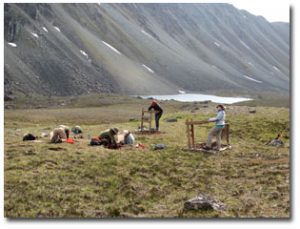 The Alaska Range uplands project investigates how prehistoric hunter-gatherers lived and hunted in the mountainous uplands of the central Alaska Range, from earliest colonization in the late Pleistocene through the late Holocene. Understanding human use of upland landscapes in central Alaska is important because we know very little about when and how initial colonizing populations adapted to this challenging landscape, and how upland subsistence activities changed throughout prehistory. Current research predicts initial forays into the uplands during the late Pleistocene, and intensified use of upland resources in the middle and late Holocene, as hunter-gatherers focused on upland hunting of caribou and sheep during the summer and fall months. Upland hunting activities may have significantly influenced prehistoric hunting technology. Research suggests that hunters took advantage of abundant upland stone resources to fashion bifacially-worked stone projectile points, instead of the osseous inset-microblade projectile points used for lowland hunting during
The Alaska Range uplands project investigates how prehistoric hunter-gatherers lived and hunted in the mountainous uplands of the central Alaska Range, from earliest colonization in the late Pleistocene through the late Holocene. Understanding human use of upland landscapes in central Alaska is important because we know very little about when and how initial colonizing populations adapted to this challenging landscape, and how upland subsistence activities changed throughout prehistory. Current research predicts initial forays into the uplands during the late Pleistocene, and intensified use of upland resources in the middle and late Holocene, as hunter-gatherers focused on upland hunting of caribou and sheep during the summer and fall months. Upland hunting activities may have significantly influenced prehistoric hunting technology. Research suggests that hunters took advantage of abundant upland stone resources to fashion bifacially-worked stone projectile points, instead of the osseous inset-microblade projectile points used for lowland hunting during 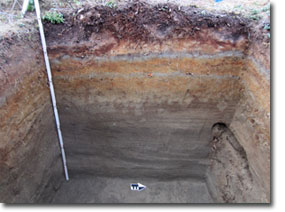 wintertime periods of stone-resource stress. However, it is difficult to assess these predictions and fully understand hunter-gatherer upland use with our current knowledge. The majority of well-documented archaeological sites in central Alaska are located in the lowlands of the Nenana and Tanana river valleys, while in the uplands of the central Alaska Range, few prehistoric sites have been fully documented. The Alaska Range uplands project is our effort to improve our knowledge of prehistoric upland activities. Our research combines archaeological, geomorphological, and paleoecological research to ask: when did humans first begin targeting resources in the uplands, and what was the environmental context of this use? How did the upland environment and use of upland resources change over time? How did use of upland resources influence stone tool manufacture, especially bifacial projectile versus inset-microblade weapons? This project encompasses research in the Nenana Valley and Denali National Park and Preserve, but is primarily focused in the upper Susitna River basin, central Alaska. The Alaska Range Uplands Project was partially funded by The Roy J. Shlemon Student Field Geoarchaeology Award, and the National Science Foundation Arctic Social Sciences Program. Since 2010, this project has provided many field and laboratory research opportunities for undergraduate and graduate students at CSFA.
wintertime periods of stone-resource stress. However, it is difficult to assess these predictions and fully understand hunter-gatherer upland use with our current knowledge. The majority of well-documented archaeological sites in central Alaska are located in the lowlands of the Nenana and Tanana river valleys, while in the uplands of the central Alaska Range, few prehistoric sites have been fully documented. The Alaska Range uplands project is our effort to improve our knowledge of prehistoric upland activities. Our research combines archaeological, geomorphological, and paleoecological research to ask: when did humans first begin targeting resources in the uplands, and what was the environmental context of this use? How did the upland environment and use of upland resources change over time? How did use of upland resources influence stone tool manufacture, especially bifacial projectile versus inset-microblade weapons? This project encompasses research in the Nenana Valley and Denali National Park and Preserve, but is primarily focused in the upper Susitna River basin, central Alaska. The Alaska Range Uplands Project was partially funded by The Roy J. Shlemon Student Field Geoarchaeology Award, and the National Science Foundation Arctic Social Sciences Program. Since 2010, this project has provided many field and laboratory research opportunities for undergraduate and graduate students at CSFA.
More about The Alaska Range Uplands Project |
Paleolithic Research in the Nenana Valley, Alaska
An important component of Center research is understanding the 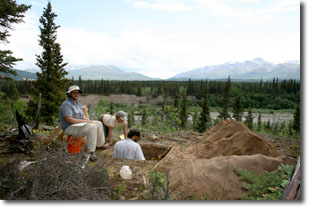 origins of the first Americans in Beringia, the region today made up of Alaska, Yukon Territory, northeast Siberia, and the now-submerged Bering Sea platform. In 2007 we resumed field research in the North Alaska Range (central Alaska), investigating important Nenana Complex sites like Walker Road, Dry Creek, and Owl Ridge. The research is centered on two problems. First, we are undertaking a comprehensive survey of the
origins of the first Americans in Beringia, the region today made up of Alaska, Yukon Territory, northeast Siberia, and the now-submerged Bering Sea platform. In 2007 we resumed field research in the North Alaska Range (central Alaska), investigating important Nenana Complex sites like Walker Road, Dry Creek, and Owl Ridge. The research is centered on two problems. First, we are undertaking a comprehensive survey of the 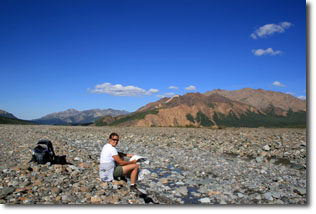 Nenana Valley’s “lithic landscape,” to understand how the first occupants of the region provisioned themselves with tool-stones. Second, we have begun a comprehensive reconnaissance survey and site-testing program in the valley. In earlier years, excavations focused on a few well-stratified sites dating chiefly to the terminal Pleistocene and situated in the Healy area of the valley. Our program is focusing on sites of all ages situated in a variety of landforms from deep in the Alaska Range north into the Tanana flats, to chronicle and explain change in hunter-gatherer technological organization and land-use throughout the last 13,000 years. Ted Goebel directs this project.
Nenana Valley’s “lithic landscape,” to understand how the first occupants of the region provisioned themselves with tool-stones. Second, we have begun a comprehensive reconnaissance survey and site-testing program in the valley. In earlier years, excavations focused on a few well-stratified sites dating chiefly to the terminal Pleistocene and situated in the Healy area of the valley. Our program is focusing on sites of all ages situated in a variety of landforms from deep in the Alaska Range north into the Tanana flats, to chronicle and explain change in hunter-gatherer technological organization and land-use throughout the last 13,000 years. Ted Goebel directs this project.
| Read More
Graf, K. E., T. Goebel (2009) Upper Paleolithic Toolstone Procurement and Selection at the Sites of Dry Creek, Alaska and Ushki-5, Russia. In Lithic Materials and Paleolithic Societies, edited by B. Blades and B. Adams, pp. 54-77. Blackwell Publishers, London. (pdf) |
Great Basin
Bonneville Estates Rockshelter, Nevada
Center staff have been excavating at Bonneville Estates Rockshelter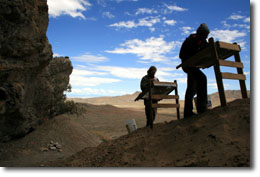 since 2000, exposing a series of well-preserved cultural layers spanning from the late Pleistocene to historic times. The rockshelter’s earliest fire hearth dates to about 10,800 to 12,800 cal BP, and an intensive Paleoindian occupation spans from about 9,500 to 11,000 cal BP. Paleoindians repeatedly revisited the rockshelter, leaving behind stemmed bifacial points and a variety of bifaces and flake tools, bone awls, cordage fragments, and bone beads. Associated ecofacts include well-preserved bones of artiodactyls (antelope, deer, bighorn sheep), small mammals, and, most interestingly, sage grouse. Amazingly, these birds appear to have been the focus of human subsistence at Bonneville Estates and indicate that Paleoindians had settled into the eastern Great Basin’s unique environment soon after the Clovis era.
since 2000, exposing a series of well-preserved cultural layers spanning from the late Pleistocene to historic times. The rockshelter’s earliest fire hearth dates to about 10,800 to 12,800 cal BP, and an intensive Paleoindian occupation spans from about 9,500 to 11,000 cal BP. Paleoindians repeatedly revisited the rockshelter, leaving behind stemmed bifacial points and a variety of bifaces and flake tools, bone awls, cordage fragments, and bone beads. Associated ecofacts include well-preserved bones of artiodactyls (antelope, deer, bighorn sheep), small mammals, and, most interestingly, sage grouse. Amazingly, these birds appear to have been the focus of human subsistence at Bonneville Estates and indicate that Paleoindians had settled into the eastern Great Basin’s unique environment soon after the Clovis era.
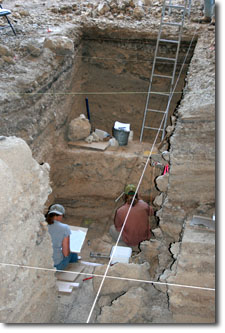 Excavations at Bonneville Estates concluded in 2009, and this will be followed by several years of multidisciplinary laboratory analyses of the materials recovered. The Bonneville Estates team has been co-directed by Ted Goebel (formerly of CSFA), Kelly Graf (formerly of CSFA), Bryan Hockett (Elko Field Office, BLM), and David Rhode (Desert Research Institute). The Bonneville Estates Rockshelter project has been funded by the National Science Foundation Archaeology Program and the United States Department of the Interior, Bureau of Land Management.
Excavations at Bonneville Estates concluded in 2009, and this will be followed by several years of multidisciplinary laboratory analyses of the materials recovered. The Bonneville Estates team has been co-directed by Ted Goebel (formerly of CSFA), Kelly Graf (formerly of CSFA), Bryan Hockett (Elko Field Office, BLM), and David Rhode (Desert Research Institute). The Bonneville Estates Rockshelter project has been funded by the National Science Foundation Archaeology Program and the United States Department of the Interior, Bureau of Land Management.
| Read More
Goebel, T., K. Graf, B. Hockett, D. Rhode (2007) The Paleoindian Occupations at Bonneville Estates Rockshelter, Danger Cave, and Smith Creek Cave (Eastern Great Basin, U.S.A.): Interpreting Their Radiocarbon Chronologies. In: On Shelter’s Ledge: Histories, Theories and Methods of Rockshelter Research, edited by M. Kornfeld, S. Vasil’ev, L. Miotti, pp. 147-161. BAR International Series. (pdf) Graf, K. E. (2007) Stratigraphy and Chronology of the Pleistocene-Holocene Transition at Bonneville Estates Rockshelter, Eastern Nevada. In Paleoindian or Paleoarchaic? Great Basin Human Ecology at the Pleistocene-Holocene Transition, edited by K. E. Graf and D. N. Schmitt, pp. 82-104. University of Utah Press, Salt Lake City. (pdf) Repanshek, K. (2007) The Bonneville Estates Rockshelter: Uncovering Thousands of Years of Occupation. American Archaeology 11(1):26-31. (pdf) |
- Entrance to Rockshelter
- Bonneville Estates, Rockshelter, Nevada
- Stratigraphy and lower hearths.
- Looking out of the shelter.
- Looking into the shelter.
- Kelly Graf points to the location of the earliest hearths.
Eastern U.S.
Page-Ladson site, Florida
Excavations at the Page-Ladson site, Florida, have revealed stone tools in association with mastodon remains within undisturbed geologic deposits. These artifacts date to 14,550 cal yr B.P. The hunter-gatherers at Page-Ladson were adapted to their local environment; knowing where to find freshwater, game, plants, stone, and other critical survival resources. Research at the site has been conducted by Jessi Halligan (Florida State University) and Mike Waters. Excavations and coring were conducted from 2012-2015 at Page-Ladson and other sites in Florida. New excavations took place from 2018-2019.
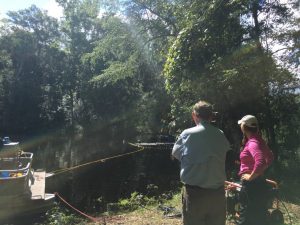
| Read More
Halligan, Jessi J., Michael R. Waters, Angelina Perrotti, Ivy J. Owens, Joshua M. Feinberg, Mark D. Bourne, Brendan Fenerty, Barbara Winsborough, David Carlson, Daniel C. Fisher, Thomas W. Stafford Jr., James S. Dunbar (2016) Pre-Clovis occupation 14,550 years ago at the Page-Ladson site, Florida, and the peopling of the Americas. Science Advances 13 May 2016. (pdf) |
Past Projects
Hogeye Clovis Cache, Texas
A cache of 54 Clovis 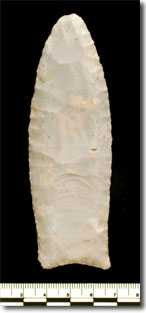 bifaces and points was discovered several years ago in a sand pit near Bastrop, Texas. Field investigations were undertaken in 2010 to define and date the stratigraphy at the site. All the bifaces are made of Edwards Chert and range from large bifaces with rounded ends, to late stage preforms, to finished projectile points.
bifaces and points was discovered several years ago in a sand pit near Bastrop, Texas. Field investigations were undertaken in 2010 to define and date the stratigraphy at the site. All the bifaces are made of Edwards Chert and range from large bifaces with rounded ends, to late stage preforms, to finished projectile points.
| Read More
Waters, M. R., and Jennings, T. A., 2015, The Hogeye Clovis Cache, Texas. College, Station, Texas A&M University Press, 151 p. |
Gault Clovis site, Texas
The Gault site, Texas contains the greatest density of buried Clovis artifacts in North America. Geoarchaeological investigations at Gault defined a complex stratigraphy of channel, bar, and floodplain sediments and buried pal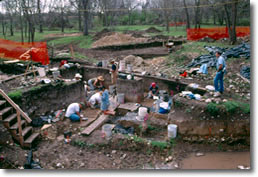 eosols. At the base of the sequence, Clovis artifacts occur in primary contexts within pond clays and in overlying floodplain deposits. Clovis artifacts include fluted projectile points, bifaces in all stages of reduction, blade cores, blades, core tablets, end scrapers, and other tools and debitage. Folsom, Late Paleoindian and Archaic artifacts occur in overlying floodplain deposits.
eosols. At the base of the sequence, Clovis artifacts occur in primary contexts within pond clays and in overlying floodplain deposits. Clovis artifacts include fluted projectile points, bifaces in all stages of reduction, blade cores, blades, core tablets, end scrapers, and other tools and debitage. Folsom, Late Paleoindian and Archaic artifacts occur in overlying floodplain deposits.
Excavations in 2000 and 2001 by Texas A&M University (Michael Waters, Harry Shafer, and David Carlson) recovered over 74,000 pieces of debitage and over 1300 artifacts, mostly from the Clovis horizons. Analyses have focused on the Clovis material and include studies of the biface and blade technologies, debitage and expedient tools, and use-wear analysis of the end scrapers and blades. In addition, the faunal material from the excavations have been analyzed, a micromorphological analysis of the sediments has been completed, and a site formation study is underway.
| Read More
Waters, M. R., Pevny, C. D., and Carlson, D. L., 2011, Clovis Lithic Technology: Investigation of a Stratified Workshop at the Gault Site, Texas. College Station, Texas A&M University Press, 226 p. |
- View of Buttermilk Creek looking south.
- View of Buttermilk Creek looking north.
- Texas A&M University excavations at Gault.
- Terrain around the Gault site.
- Seep spring at Gault.
- Seep spring at Gault.
- Map of Texas showing the location of Gault and other Clovis
- Clovis artifacts in place in the Clovis soil.
- Chert nodulesin the Edwards Limestone.
- Block excavation taken to limestone bedrock..
Dry Creek, Alaska
During July and August of 2011 we renewed excavations at the Dry 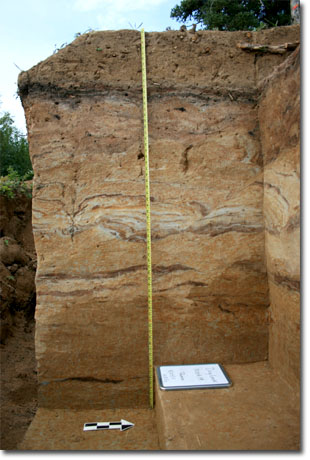 Creek site to better understand the geoarchaeological context of the site’s late Pleistocene human occupations. The site is located on the Healy-aged glacial outwash terrace along the Nenana River near the town of Healy, Alaska. At one time Dry Creek was considered the most important late Pleistocene site in Alaska because it provided multiple terminal Pleistocene cultural components, reflecting at least two separate occupations of the region before the onset of the Holocene: one dating to about 13,500-13,000 calendar years ago and a second dating to about 12,000 calendar years ago. Recently, some have questioned the geoarchaeological integrity and separation of Dry Creek’s two archaeological layers.
Creek site to better understand the geoarchaeological context of the site’s late Pleistocene human occupations. The site is located on the Healy-aged glacial outwash terrace along the Nenana River near the town of Healy, Alaska. At one time Dry Creek was considered the most important late Pleistocene site in Alaska because it provided multiple terminal Pleistocene cultural components, reflecting at least two separate occupations of the region before the onset of the Holocene: one dating to about 13,500-13,000 calendar years ago and a second dating to about 12,000 calendar years ago. Recently, some have questioned the geoarchaeological integrity and separation of Dry Creek’s two archaeological layers. 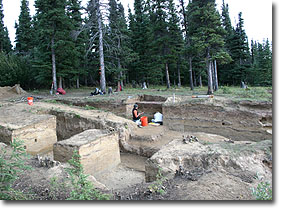 Our main objective for revisiting Dry Creek was to investigate site formation and test the site’s geological integrity. We found clear stratigraphic separation between these components and hearths that place the lowest component at 13,500-13,400 cal BP and the second component at 10,700 cal BP. We continue to conduct post-fieldwork research on materials from the site.
Our main objective for revisiting Dry Creek was to investigate site formation and test the site’s geological integrity. We found clear stratigraphic separation between these components and hearths that place the lowest component at 13,500-13,400 cal BP and the second component at 10,700 cal BP. We continue to conduct post-fieldwork research on materials from the site.
| Read More
Graf, Kelly E., L. M. DiPietro, K. E. Krasinski, B. J. Culleton, D. Kennett, A. K. Gore, H. L. Smith (2017) Chapter 8: New Geoarchaeology and Geochronology at Dry Creek. In Dry Creek: Archaeology and Paleoecology of a Late Pleistocene Alaskan Hunting Camp, by W. R. Powers, R. D. Guthrie, J. F. Hoffecker, edited by T. Goebel. Texas A&M University Press, College Station, p. 219-260. |
Serpentine Hot Springs, Bering Land Bridge National Park, Alaska
Since 2009, CSFA archaeologists have been excavating the  Serpentine Hot Springs fluted-point site, located in Bering Land Bridge National Preserve, Alaska. Excavations have yielded some of the first fluted points in a stratified and datable context in Alaska. Through 2010, two hearth features had been uncovered, and each was associated with a fragment of a fluted poi
Serpentine Hot Springs fluted-point site, located in Bering Land Bridge National Preserve, Alaska. Excavations have yielded some of the first fluted points in a stratified and datable context in Alaska. Through 2010, two hearth features had been uncovered, and each was associated with a fragment of a fluted poi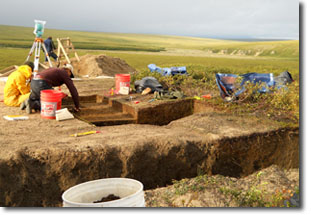 nt. Charcoal from the hearths suggest an age of about 12,000 calendar years ago. A total of six fluted-point fragments have been recovered from the site so far; they are very similar technologically and morphologically to fluted points from other surface or near-surface Alaskan sites-they have deeply concave bases and multiple flutes, and technologically they seem to have been fluted using an instrument-assisted approach. The results of our work suggest that fluted-point technology spread into Alaska from temperate North America after the time of Clovis.
nt. Charcoal from the hearths suggest an age of about 12,000 calendar years ago. A total of six fluted-point fragments have been recovered from the site so far; they are very similar technologically and morphologically to fluted points from other surface or near-surface Alaskan sites-they have deeply concave bases and multiple flutes, and technologically they seem to have been fluted using an instrument-assisted approach. The results of our work suggest that fluted-point technology spread into Alaska from temperate North America after the time of Clovis.
| Read More
Goebel, T., H. Smith, L. DiPietro, M. Waters, B. Hockett, K. Graf, R. Gal, S. Slobodin, R. Speakman, S. Driese, and D. Rhode (2013) Serpentine Hot Springs, Alaska: Results of Excavations and Implications for the Age and Significance of Northern Fluted Points. Journal of Archaeological Science 40:4222-4233 (pdf) |
Owl Ridge, Alaska
In 2007 we renewed excavation of the Owl Ridge site, located along the Teklanika River in central Alaska. Owl Ridge is an important early site in the region because it contains two terminal Pleistocene-aged cultural occupations: one dating to about 13,000 calendar years ago and a second dating to about 12,000 calendar years ago. Our objectives for this 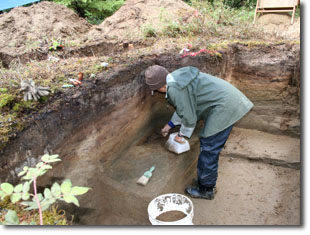 project have been to establish a reliable chronology for the site’s multiple occupations, increase the artifact sample from each of the components, and search for cultural features to help reconstruct site activities and better understand how the site was used during each occupation. In 2009 we spent 3 weeks with a small crew of 3 graduate students and opened 14m2. In 2010 we excavated for 6 weeks with a crew of 10 (including 4 undergraduate and 4 graduate students), opening an additional 37m2. We found artifact clusters associated with all 3 cultural occupations. Additionally, we reaffirmed the Allerød age of the Nenana complex layers and established a Younger Dryas age for the Denali complex layer. Currently, we are analyzing materials from the excavations and preparing preliminary reports on our results. Kelly Graf is directing this project with assistance from Ted Goebel (spatial analysis), Mike Waters (Geoarchaeology), and Nancy Bigelow (palynology). The 2009-2010 Owl Ridge excavation project was funded by the National Science Foundation’s Archaeology and Arctic Sciences programs. Initial testing of the site in 2007 was partially funded by Elmer A. Guerri.
project have been to establish a reliable chronology for the site’s multiple occupations, increase the artifact sample from each of the components, and search for cultural features to help reconstruct site activities and better understand how the site was used during each occupation. In 2009 we spent 3 weeks with a small crew of 3 graduate students and opened 14m2. In 2010 we excavated for 6 weeks with a crew of 10 (including 4 undergraduate and 4 graduate students), opening an additional 37m2. We found artifact clusters associated with all 3 cultural occupations. Additionally, we reaffirmed the Allerød age of the Nenana complex layers and established a Younger Dryas age for the Denali complex layer. Currently, we are analyzing materials from the excavations and preparing preliminary reports on our results. Kelly Graf is directing this project with assistance from Ted Goebel (spatial analysis), Mike Waters (Geoarchaeology), and Nancy Bigelow (palynology). The 2009-2010 Owl Ridge excavation project was funded by the National Science Foundation’s Archaeology and Arctic Sciences programs. Initial testing of the site in 2007 was partially funded by Elmer A. Guerri.
| Read More
Graf, Kelly E., Angela K. Gore, J. Anne Melton, Tarah Marks, Lyndsay DiPietro, Ted Goebel, Michael R. Waters, David Rhode (2019) Recent excavations at Owl Ridge, interior Alaska: Site stratigraphy, chronology, and site formation and implications for late Pleistocene archaeology and peopling of eastern Beringia. Geoarchaeology 2019;1–24. (pdf) |
Manis Mastodon Site, Washington
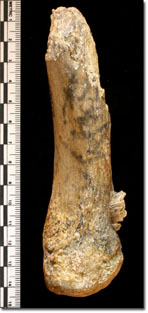 In 1973, a single mastodon was excavated on the Olympic Peninsula by Carl Gustavson. The mastodon remains were dated to about 14,000 years ago and the animal appeared to have been butchered by humans. No stone tools were found at the site, but one rib of the mastodon had a bone object embedded in it. Gustavson interpreted this to be a bone projectile point. For many years the evidence from this site has been debated. Using modern technologies-advanced AMS radiocarbon dating technology, high resolution X-ray CT imaging, and DNA and protein sequencing-we reanalyzed the evidence from the Manis site. This re-examination shows that the object is a bone projectile point and that the site is 14,000 years old. This provides unequivocal evidence of pre-Clovis mastodon hunting at the close of the Ice Age.
In 1973, a single mastodon was excavated on the Olympic Peninsula by Carl Gustavson. The mastodon remains were dated to about 14,000 years ago and the animal appeared to have been butchered by humans. No stone tools were found at the site, but one rib of the mastodon had a bone object embedded in it. Gustavson interpreted this to be a bone projectile point. For many years the evidence from this site has been debated. Using modern technologies-advanced AMS radiocarbon dating technology, high resolution X-ray CT imaging, and DNA and protein sequencing-we reanalyzed the evidence from the Manis site. This re-examination shows that the object is a bone projectile point and that the site is 14,000 years old. This provides unequivocal evidence of pre-Clovis mastodon hunting at the close of the Ice Age.
Watch Dr. Michael Waters discuss the evidence from the Manis Mastodonsite in an interview conducted by the publishers of Science.
| Read More
Waters, Michael R. , Thomas W. Stafford Jr., H. Gregory McDonald, Carl Gustafson, Morten Rasmussen, Enrico Cappellini, Jesper V. Olsen, Damian Szklarczyk, Lars Juhl Jensen, M. Thomas P. Gilbert, and Eske Willerslev (2011) Pre-Clovis Mastodon Hunting 13,800 Years Ago at the Manis Site, Washington. Science 334:351-353. |
- Side view of rib with projectile
- Mastodon rib with antler projectile embedded
- Rib with projectile
- CT scanning of the rib from the Manis Mastodon
- Close up of embedded antler projectile
- Close up of antler projectile and rib
- Another view
Mud Lake, Wisconsin
Near Mud Lake, Wisconsin (Kenosha County), the fore limb and toe bones of a mammoth were recovered in the 1930s 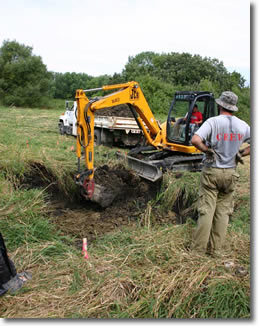 and these bones showed extensive evidence of butchering. Later radiocarbon dating by Dan Joyce (Curator of Archaeology, Kenosha Public Museum) showed that the bones were 13,500 14C yr B.P. In partnership with Dan Joyce, Mike Waters conducted an extensive hand coring operation in 2004 that resulted in the definition of the site stratigraphy and four target areas where the mammoth bones could have originally come from based on historical accounts. In 2004 and 2005 we extensively tested all four areas. These tests failed to find any additional traces of the mammoth. Radiocarbon dates on wood obtained from the trenches confirms that we were in the correct location and examining sediments of the correct age in our search for the Mud Lake Mammoth. The Mud Lake mammoth bones were studied at the Kenosha Public Museum by Haskell Greenfield. A final report of the site is being prepared.
and these bones showed extensive evidence of butchering. Later radiocarbon dating by Dan Joyce (Curator of Archaeology, Kenosha Public Museum) showed that the bones were 13,500 14C yr B.P. In partnership with Dan Joyce, Mike Waters conducted an extensive hand coring operation in 2004 that resulted in the definition of the site stratigraphy and four target areas where the mammoth bones could have originally come from based on historical accounts. In 2004 and 2005 we extensively tested all four areas. These tests failed to find any additional traces of the mammoth. Radiocarbon dates on wood obtained from the trenches confirms that we were in the correct location and examining sediments of the correct age in our search for the Mud Lake Mammoth. The Mud Lake mammoth bones were studied at the Kenosha Public Museum by Haskell Greenfield. A final report of the site is being prepared.
Topper site, South Carolina
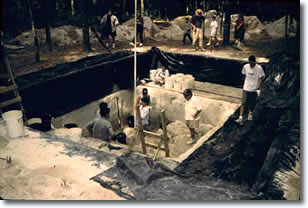 The Topper site is a proposed Pre-Clovis locality that is being excavated under the direction of Dr. Al Goodyear (South Carolina Institute of Archaeology and Anthropology). Michael Waters in conjunction with Steve Forman (University of Illinois, Chicago), Tom Stafford (Stafford Research Laboratories), and John Foss (University of Tennessee) conducted geoarchaeological investigations of the site from 1999 to 2004. A final report on the geology of the site is nearing completion. While the geological context and age of the sediments that contain the reported Pre-Clovis artifacts are secure, questions remain about the origin of the reported artifacts. The Topper assemblage may be the result of human manufacture or may also be the result of natural thermal spalling.
The Topper site is a proposed Pre-Clovis locality that is being excavated under the direction of Dr. Al Goodyear (South Carolina Institute of Archaeology and Anthropology). Michael Waters in conjunction with Steve Forman (University of Illinois, Chicago), Tom Stafford (Stafford Research Laboratories), and John Foss (University of Tennessee) conducted geoarchaeological investigations of the site from 1999 to 2004. A final report on the geology of the site is nearing completion. While the geological context and age of the sediments that contain the reported Pre-Clovis artifacts are secure, questions remain about the origin of the reported artifacts. The Topper assemblage may be the result of human manufacture or may also be the result of natural thermal spalling.
| Read More
Waters, Michael R., Steven L. Forman, Thomas W. Stafford, Jr. and John Foss (2009) Geoarchaeological investigations at the Topper and Big Pine Tree sites, Allendale County, South Carolina. Journal of Archaeological Science 36:1300-1311. (pdf) |
Clovis Dating Project
 A multi-year project was undertaken to refine the Clovis chronology. Clovis had been historically dated at a number of sites across North America from 11,500 to 10,900 14C yr B.P. However, these dates were obtained over a 40 year period on a variety of materials and utilized a range of older radiocarbon technologies. Thus, there was a need to obtain new dates from many of the previously dated Clovis sites using modern pre-treatment procedures and the atomic accelerator. An evaluation of the radiocarbon dates from all the dated Clovis sites, as well as new radiocarbon dates from many of these sites provided startling results. The radiocarbon dates from the Clovis sites of Lange-Ferguson (South Dakota), Sloth Hole (Florida), Anzick (Montana), Dent (Colorado), Paleo Crossing (Ohio), Domebo (Oklahoma), Lehner (Arizona), Shawnee-Minisink (Pennsylvania), Murray Springs (Arizona), Colby (Wyoming), and Jake Bluff (Oklahoma) all ranged from roughly 11,100 to 10,800 14C yr B.P. When calibrated, these dates fall between 13,200 – 13,100 to 12,900 cal yr B.P. This indicated that Clovis dated to a much narrower time window than previously indicated by the historically older dates. Furthermore, the start of Clovis was much younger than previously thought. These findings had serious consequences for the Clovis First model. The results of this study were published in the journal Science.
A multi-year project was undertaken to refine the Clovis chronology. Clovis had been historically dated at a number of sites across North America from 11,500 to 10,900 14C yr B.P. However, these dates were obtained over a 40 year period on a variety of materials and utilized a range of older radiocarbon technologies. Thus, there was a need to obtain new dates from many of the previously dated Clovis sites using modern pre-treatment procedures and the atomic accelerator. An evaluation of the radiocarbon dates from all the dated Clovis sites, as well as new radiocarbon dates from many of these sites provided startling results. The radiocarbon dates from the Clovis sites of Lange-Ferguson (South Dakota), Sloth Hole (Florida), Anzick (Montana), Dent (Colorado), Paleo Crossing (Ohio), Domebo (Oklahoma), Lehner (Arizona), Shawnee-Minisink (Pennsylvania), Murray Springs (Arizona), Colby (Wyoming), and Jake Bluff (Oklahoma) all ranged from roughly 11,100 to 10,800 14C yr B.P. When calibrated, these dates fall between 13,200 – 13,100 to 12,900 cal yr B.P. This indicated that Clovis dated to a much narrower time window than previously indicated by the historically older dates. Furthermore, the start of Clovis was much younger than previously thought. These findings had serious consequences for the Clovis First model. The results of this study were published in the journal Science.
| Read More
Waters, Michael R., Thomas W. Stafford Jr. (2007) Redefining the Age of Clovis: Implications for the Peopling of the Americas. Science 23 February 2007. (pdf) |
Brazoria Woman, Texas
Brazoria County, Texas a human skeleton was found at a site designated BZT-1. Preliminary radiocarbon dates suggested that these remains were around 10,700 years old. This would make the Brazoria skeleton one of the oldest skeletons found in North America. Archaeological and geoarchaeological 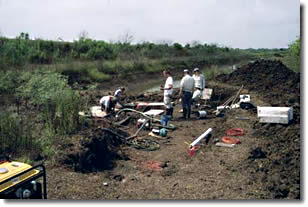 investigations were undertaken at BZT-1 in 2003. The research team successfully removed the human skeleton and recorded the geology of the site. In 2004, the skeleton was analyzed. The remains are those of a young adult female that was intentionally buried face-down with hands crossed in the front in an extended position. Cause of death was indeterminate. Careful analysis of the previous radiocarbon dates obtained from the bone and teeth of this skeleton showed that they were on very small carbon samples from non-collagenous fractions. Thus, the late Pleistocene radiocarbon ages previously reported are not valid. Additional bone samples yielded insufficient carbon for a radiocarbon age. A sample of marine shell in close proximity to the skeleton yielded an age of 5600 14C yr B.P. A similar age was obtained from a shell midden in the same stratigraphic position, about 100 m from the skeleton. Thus, the Brazoria Woman fossil is not late Pleistocene, but instead is middle Holocene in age.
investigations were undertaken at BZT-1 in 2003. The research team successfully removed the human skeleton and recorded the geology of the site. In 2004, the skeleton was analyzed. The remains are those of a young adult female that was intentionally buried face-down with hands crossed in the front in an extended position. Cause of death was indeterminate. Careful analysis of the previous radiocarbon dates obtained from the bone and teeth of this skeleton showed that they were on very small carbon samples from non-collagenous fractions. Thus, the late Pleistocene radiocarbon ages previously reported are not valid. Additional bone samples yielded insufficient carbon for a radiocarbon age. A sample of marine shell in close proximity to the skeleton yielded an age of 5600 14C yr B.P. A similar age was obtained from a shell midden in the same stratigraphic position, about 100 m from the skeleton. Thus, the Brazoria Woman fossil is not late Pleistocene, but instead is middle Holocene in age.
| Read More
Waters, M. R., J. Wiersema and T. W. Stafford, Jr. (2008) A geoarchaeological evaluation of an early human burial from Brazoria County, Texas. Journal of Archaeological Science 35:2425-2433. (pdf) |
Toloquilla Quarry (Footprint) Locality, Mexico
In 2005, a research team in England announced the discovery of hundreds of human footprints in a stone quarry south of Puebla, Mexico. These human footprints were within a volcanic tuff known as the Xalnene. The English team reported that the  footprints were over 40,000 years old. The Toloquilla Quarry is very close to the site of Hueyatlaco. While working at Hueyatlaco, several visits were made to the Toloquilla Quarry to examine the reported footprints and obtain samples for dating. Samples of the Xalnene Tuff were collected and taken to the Berkeley Geochronology Center for Argon-Argon and Paleomagnetic dating. These results showed that the rock in which the reported footprints occurred was 1.3 million years old. The marks on the floor of the quarry, that have been interpreted as human footprints by the English team, are likely marks made during the quarrying of the stone for building material. This research was done in collaboration with Paul Renne, Joshua Feinberg, and Kim Knight (Berkeley Geochronology Center); and Joaquin Arroyo-Cabrales (INAH), Patricia Ochoa-Castillo (National Museum of Anthropology), and Mario Perez-Campa (INAH).
footprints were over 40,000 years old. The Toloquilla Quarry is very close to the site of Hueyatlaco. While working at Hueyatlaco, several visits were made to the Toloquilla Quarry to examine the reported footprints and obtain samples for dating. Samples of the Xalnene Tuff were collected and taken to the Berkeley Geochronology Center for Argon-Argon and Paleomagnetic dating. These results showed that the rock in which the reported footprints occurred was 1.3 million years old. The marks on the floor of the quarry, that have been interpreted as human footprints by the English team, are likely marks made during the quarrying of the stone for building material. This research was done in collaboration with Paul Renne, Joshua Feinberg, and Kim Knight (Berkeley Geochronology Center); and Joaquin Arroyo-Cabrales (INAH), Patricia Ochoa-Castillo (National Museum of Anthropology), and Mario Perez-Campa (INAH).
| Read More
Feinberg, Joshua M., Paul R. Renne, Joaquin Arroyo-Cabrales, Michael R. Waters, Patricia Ochoa-Castillo and Mario Perez-Campa (2009) Age constraints on alleged “footprints” preserved in the Xalnene Tuff near Puebla, Mexico. Geology 37:267-270. (pdf) Renne, Paul R., Joshua M. Feinberg, Michael R. Waters, Joaquin Arroyo-Cabrales, Patricia Ochoa-Castillo, Mario Perez-Campa and Kim B. Knight (2005) Geochronology: Age of Mexican ash with alleged ‘footprints’. Nature 438:E7-E8. |
The Ushki site, Kamchatka, Russia
In 2000, Ted Goebel and Michael Waters joined Margarita Dikova in a re-excavation of the Ushki site, located in central Kamchatka, Russia. The goal of the project was to document the existence of a 16,000-year-old cultural occupation labeled layer 7, which many archaeologists had pointed to as a possible Clovis ancestor. We 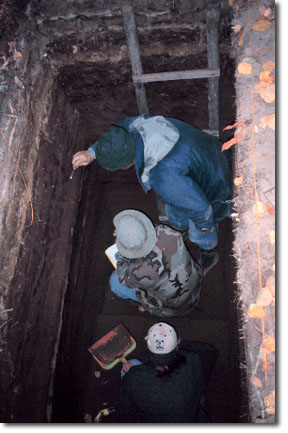 focused our study on two loci of the Ushki sites, Ushki-1 and Ushki-5, excavating test pits at both localities and opening a 5-x-5-m block at Ushki 5. In every excavation we identified layer 7, and collected ancient charcoal samples for radiocarbon dating. In every case the charcoal yielded radiocarbon ages of about 13,000 calendar years ago, 3000 years younger than earlier dating results suggested. Our work demonstrated that layer 7 at Ushki is too young to be an ancestor of Clovis. Instead, it seems to date to the same time as Clovis, as well as to the same time as the Nenana complex in central Alaska. The lithic assemblages from layer 7 at Ushki and the Nenana complex sites are very similar, and could represent the same population of early Asians expanding into Beringia during the late Pleistocene. How they relate to Clovis south of the Canadian ice sheets is one of the unsolved mysteries our Beringian research program continues to examine.
focused our study on two loci of the Ushki sites, Ushki-1 and Ushki-5, excavating test pits at both localities and opening a 5-x-5-m block at Ushki 5. In every excavation we identified layer 7, and collected ancient charcoal samples for radiocarbon dating. In every case the charcoal yielded radiocarbon ages of about 13,000 calendar years ago, 3000 years younger than earlier dating results suggested. Our work demonstrated that layer 7 at Ushki is too young to be an ancestor of Clovis. Instead, it seems to date to the same time as Clovis, as well as to the same time as the Nenana complex in central Alaska. The lithic assemblages from layer 7 at Ushki and the Nenana complex sites are very similar, and could represent the same population of early Asians expanding into Beringia during the late Pleistocene. How they relate to Clovis south of the Canadian ice sheets is one of the unsolved mysteries our Beringian research program continues to examine.
| Read More
Goebel, Ted, S. B. Slobodin, M. R. Waters (2010) New Dates from Ushki-1, Kamchatka, confirm 13,000 cal BP age for earliest Paleolithic occupation. Journal of Archaeological Science 37:2640-2649. (pdf) Graf, Kelly E., Ted Goebel (2009) Upper Paleolithic Toolstone Procurement and Selection at the Sites of Dry Creek, Alaska and Ushki-5, Russia. In Lithic Materials and Paleolithic Societies, edited by B. Blades and B. Adams, pp. 54-77. Blackwell Publishers, London. (pdf) Goebel, Ted., Michael R. Waters and Margarita Dikova (2003) The Archaeology of Ushki Lake, Kamchatka, and the Pleistocene Peopling of the Americas. Science 301:501-505. (pdf) |
Upper Paleolithic Research in the Transbaikal, Siberia
In the late 1990s, Ted Goebel and Michael Waters joined Russian archaeologists on a series of expeditions to Upper Paleolithic sites in 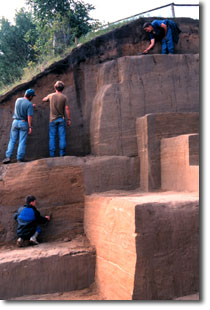 the Transbaikal region of southeast Siberia. We investigated the geoarchaeology of some important archaeological sites, including the early Upper Paleolithic sites of Tolbaga and Masterov Kliuch, and the late Upper Paleolithic site of Studenoe-2. These studies focused primarily on site-formation processes and dating. The early Upper Paleolithic sites dated to around 30,000 years ago and were significantly disturbed by colluvial and cryogenic processes, while the late Upper Paleolithic occupations dated to less than 17,000 years ago and were well-preserved in low-energy floodplain deposits.
the Transbaikal region of southeast Siberia. We investigated the geoarchaeology of some important archaeological sites, including the early Upper Paleolithic sites of Tolbaga and Masterov Kliuch, and the late Upper Paleolithic site of Studenoe-2. These studies focused primarily on site-formation processes and dating. The early Upper Paleolithic sites dated to around 30,000 years ago and were significantly disturbed by colluvial and cryogenic processes, while the late Upper Paleolithic occupations dated to less than 17,000 years ago and were well-preserved in low-energy floodplain deposits.
| Read More
Goebel, Ted, Michael R. Waters, Ian Buvit, Mikhail V. Konstantinov and Aleksander V. Konstantinov (2000) Studenoe-2 and the origins of microblade technologies in the Transbaikal, Siberia. Antiquity 74:567-575. (pdf) |

